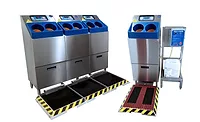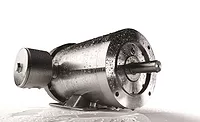FDA Promotes Good Aquaculture Practices

Consumers are more concerned than ever about the safety of the food they eat, and they demand that their food not be contaminated. Whether it is corn, eggs, apples, various meat products or farm-raised shrimp, food safety and quality truly begins on the farm. Good aquaculture practice guidelines are needed as an adjunct to the U.S. Food and Drug Administration's (FDA) Seafood Hazards and Controls Guide because aquacultured seafood can be a source of pathogens and other contaminants.
This article will present information on FDA's seafood safety program, describe a new long-term project to promote good aquaculture practices and provide security recommendations for aquaculture farms. The project involves studies and pilot projects in foreign countries to determine the effect of various local practices and conditions on Salmonella levels in aquacultured, raw seafood products and to develop preventive controls or Good Aquaculture Practices (GAPs) necessary to minimize the potential for farm-raised fishery products to be contaminated with pathogens, chemicals, filth, and unapproved or misused animal drugs.
FDA's Responsibilities for Seafood
FDA is responsible for administering the Federal Food, Drug, and Cosmetic Act which prohibits adulterated and misbranded food, including seafood, in interstate commerce and the Public Health Service Act, which authorizes measures to prevent the spread of communicable diseases. The Office of Seafood in FDA's Center for Food Safety and Applied Nutrition (CFSAN) provides direction to the seafood program and engages in research in furtherance of FDA's public health mission. Staff from FDA's Office of Regulatory Affairs' District offices located around the country conduct inspections of commercial seafood processors and FDA's Center for Veterinary Medicine (CVM) regularly collaborates with CFSAN's seafood program on matters relating to aquaculture. As the number of aquaculture facilities grows, so does the need to develop safe and effective drugs for treating fish diseases. CVM is working with various government agencies and aquaculture associations to increase the number of safe and effective drugs that can be used by the aquaculture industry. CVM is responsible for approving drugs for use in aquacultured species and developing and approving methodologies for the detection of drug residues in aquacultured fish. CVM also conducts aquaculture research.
Regulations and Guidelines
FDA published "Procedures for the Safe and Sanitary Processing and Importing of Fish and Fishery Products" in December 1995, requiring processors of fish and fishery products to develop and implement Hazard Analysis and Critical Control Point (HACCP) systems for their operations (www.cfsan.fda.gov/ ~lrd/fr951218.html). Processors had two years to prepare before the regulation became effective in December 1997. In September 1996, to assist processors in developing their HACCP plans by providing information to help identify hazards that may be associated with their products and to formulate control strategies for those hazards, FDA published the "Fish and Fishery Products Hazards and Controls Guide." This guide has been updated with the third edition published in June 2001 (www.cfsan.fda.gov/~comm/haccp4.html).
FDA often publishes guidance for industry. These guidance documents represent the agency's current thinking on appropriate measures that can be taken to prevent or control problems associated with products FDA regulates. Guidance provided by FDA is used to direct domestic and international food producers in growing, harvesting, sorting, packing and storage operations to reduce food safety hazards. FDA plans to develop Good Manufacturing Practice (GMP) guidelines for harvest vessels and aquaculture farms in an effort to minimize the likelihood that food safety hazards will occur at these locations.
Aquacultured seafood currently enjoys a worldwide reputation as a safe and wholesome food. To maintain this status, researchers and investigators from the FDA's Office of Seafood visit aquaculture farms around the world to determine what preventive controls or Good Aquaculture Practices (GAPs) are necessary to minimize the potential for farm raised fishery products to be adulterated with pathogens, chemicals, filth, and unapproved or misused animal drugs.
There is general agreement on the need for GAPs, many aspects of which are already in place at some facilities. GAPs are intended not only to be a proactive measure in reducing the potential problems of aquacultured products becoming contaminated with known pathogens, chemicals and filth, but also to reduce the likelihood of unanticipated problems from occurring. FDA hopes that with implementation of the GAP measures, problems such as those that recently occurred with chloramphenicol in shrimp might be avoided. (See Siedebar, "FDA Action on Unapproved Antibiotics in Shrimp and Crayfish.")
Collaborative Research Project
In the process of developing GAPs, FDA is conducting a collaborative research project with the aquaculture industry and the aquaculture regulatory agencies of seven other countries to determine potential microbiological, chemical and drug-use hazards on aquaculture farms, and how these might best be controlled. The next positive step will be to use this information to develop and present training for farm workers to ensure aquacultured seafood continues to be recognized as a safe and wholesome food.
GAPs will only work if they give aquaculture farmers practical and reasonable controls to help them minimize the occurrence of contamination in their products. This is why FDA staff are working on site with representatives from the aquaculture industry and government agencies to proactively develop these GAPs. FDA is pleased that there has been universal support and approval for the collaborative studies from the international aquaculture industry, government agencies, processors and importers. In fact, now that the project is underway, FDA has been overwhelmed with requests from aquaculture associations and foreign government agencies to conduct studies in their countries.
The reason for this strong support by the aquaculture industry and other government agencies is simple: This industry is receiving critical advice and cutting-edge recommendations on how to directly and substantially reduce the risk that its products might not be safe and wholesome. Each aquaculture farmer that has participated in this study has benefitted directly through the interaction with FDA and other researchers. All of the participants have gained a better understanding of the roles and responsibilities each plays in the production and regulation of aquaculture.
Thus far, aquaculture farms in four countries have been studied and approximately 1,000 samples have been analyzed for fecal coliforms, E. coli and Salmonella. In addition, approximately 150 farm managers have been interviewed. Plans have been completed to conduct studies in three additional countries this fiscal year. The overwhelming observational and analytical evidence to date shows that there are reasonable and practical solutions farmers can implement to reduce fecal coliforms and the potential of Salmonella on their farms.
A report on the possible sources of microbiological and chemical contamination at aquaculture sites is expected in Fall 2003. "Train the trainer" education for farmers will follow and this will be a collaborative effort between the FDA, other country government agencies, academia, and the aquaculture industry representatives that are involved in this effort worldwide.
Security Recommendations
FDA has met with food industry representatives and trade associations to compile basic food security recommendations. The recommendations are applicable to nearly any aquaculture farm or establishment involved in growing, processing or handling seafood supplies. For example, it has been recommended that:
• A perimeter fence be set around aquaculture farms and their facilities.
• All doors, windows, outside storage tanks and other ancillary facilities should be locked or protected by guards, alarms, video equipment or other security.
• All visitors check in at a security or reception desk to get a visitor's badge, and then be accompanied throughout the facility.
• Identification badges should be provided to all employees.
• Facility managers keep track of employees on duty and where they are authorized to work.
• Employers and employees should watch for suspicious or unusual behavior, such as workers arriving unusually early or staying unusually late, bringing in cameras or asking sensitive questions.
• Reagents and cultures in on-site laboratories, and hazardous chemicals like cleaning compounds and pesticides, should be accounted for and secured.
• Access to critical computer systems be restricted through passwords and firewalls.
• Missing or excess inventory of raw materials or finished products should be investigated.
• Wells, water storage tanks and chlorine water should be secured, where possible.
Conclusion
Perceived safety, wholesomeness and the nutritional value of a food product greatly influence consumer buying decisions. For these reasons, the aquaculture industry would benefit from widespread producer commitment to implementing GAPs. GAPs are intended to not only be proactive in reducing the current risk of aquacultured products being contaminated with pathogens, chemicals and filth, but also to reduce or eliminate subsequent seafood safety issues. By reducing the risk of incidents that could erode consumer confidence in the safety, quality and wholesomeness of aquacultured seafood products, implementing GAPs will help the industry protect--and even expand--its markets.
Brett Koonse is currently leading the development of Good Aquaculture Practice guidelines in FDA's Center for Food Safety and Applied Nutrition's Office of Seafood. From 1997 to 2003, he was the Chief of the Programs and Enforcement Branch in the Office of Seafood. During this period he was an integral component of the management team developing polices to implement the new mandatory seafood HACCP regulation. Koonse joined FDA in 1991 as a Regional Shellfish Specialist in the Southeast Regional Office in Atlanta and transferred to the Office of Seafood in 1993. He previously worked with the Texas Department of Health.
Peter A. Salsbury is a science policy analyst in FDA's Center for Food Safety and Applied Nutrition's Executive Operations Staff. He is responsible for food safety policy issues that include initiatives with FDA's Office of Regulatory Affairs (field operations) and activities with other federal, state and local government agencies. He is currently serving as Acting Special Assistant to the Director, CFSAN. He served as Acting Chief of the Programs and Enforcement Branch in CFSAN's Office of Seafood from September 2002-January 2003. Salsbury has worked for FDA since 1987.
Acknowledgments
The authors thank William Jones, Ph.D., aquaculture expert in CFSAN's Office of Seafood, and Sebastian Cianci, policy analyst with CFSAN's Executive Operations Staff, for their assistance on this article.
This article is based on articles by Brett Koonse published in the Global Aquaculture Advocate, August 2002 and October 2002 issues.
FDA Action on Unapproved Antibiotics in Shrimp and Crayfish
The U.S. Food and Drug Administration (FDA) announced in June 2002 that it would be increasing the sampling of imported shrimp and crayfish (also known as crawfish) for the presence of chloramphenicol. FDA took this action because low levels of chloramphenicol had been detected by some states and other countries in imported shrimp and crayfish.
Chloramphenicol is a potent, broad-spectrum antibiotic drug used only at therapeutic doses for treatment of serious infections in humans. Due to the unpredictable dose-response effects on different patient populations, it has not been possible to identify a safe level of human exposure to chloramphenicol. Therefore, federal regulations prohibit its use in food-producing animals and animal feed products.
"The FDA is concerned about any detection of chloramphenicol in shrimp and crayfish, " said Lester M. Crawford, Ph.D., FDA Deputy Commissioner. "The agency will take whatever action is necessary to protect the public health."
Until recently, the sensitivity of the methodology to detect chloramphenicol in shrimp allowed the drug to be detected down to the 5 parts per billion (ppb) level. Recently, Canada and the European Union (EU) have refined their methods to detect even lower levels and have taken action on food products from China and Vietnam found to be contaminated by chloramphenicol. The FDA has modified its methodology to confirm chloramphenicol levels in shrimp and crayfish to 1 ppb and is further modifying the methods to detect at 0.3 ppb, which will place the U.S. methodology in line with Canada and the EU.
The agency has significantly increased its sampling and analytical resources to help control shrimp importation that does not conform to the agency's public health requirements. FDA has an established field-testing program for drug residues directed at both domestic and imported aquaculture, which includes chloramphenicol in shrimp. The regulatory testing of residues in seafood is performed in several FDA field labs that are equipped to conduct these analyses. FDA is exploring the use of other federal and state regulatory laboratories to increase sample test capacities even further.
FDA has engaged the international community on the chloramphenicol issue. FDA met with a delegation of Chinese officials following findings of chloramphenicol in imported shrimp from China. FDA informed the delegation that it would take enforcement action against any imported products found to contain chloramphenicol. Since that time, FDA has had in place an import seafood assignment to collect and analyze shrimp for chloramphenicol. Product from any country found to contain chloramphenicol cannot be imported into the United States. In addition, shipments from any country whose product has tested positive for chloramphenicol are automatically Detained Without Physical Examination (refused entry) until the importer can prove the product does not contain chloramphenicol. This policy remains in effect.
Looking for quick answers on food safety topics?
Try Ask FSM, our new smart AI search tool.
Ask FSM →








